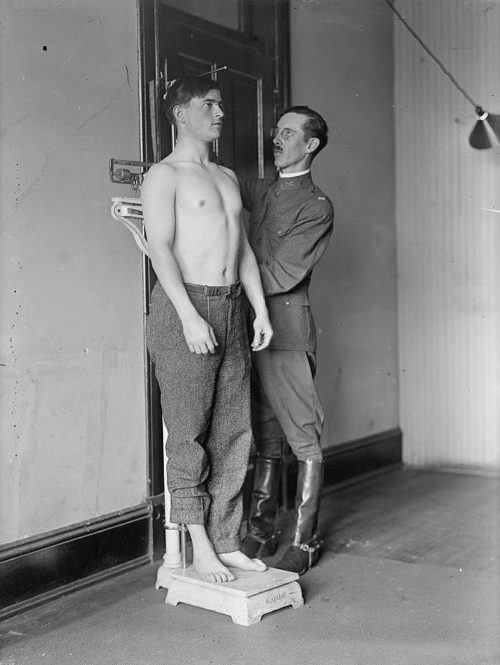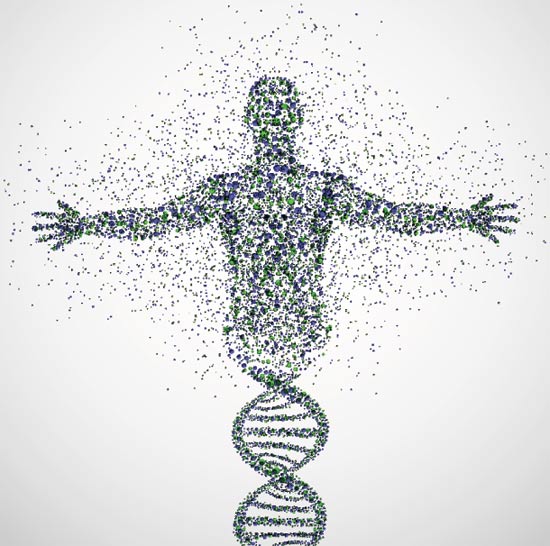The Average American Today and on the Eve of World War I

The First World War, which the U.S. entered 100 years ago today, is so far in our past that it can feel like ancient history. How can we understand the U.S. of 1917 when so much has changed since then?
One way is to compare what it means to be an “average American” then and now, though we’re fairly certain that Saturday Evening Post readers are, on the whole, above average.
If you were an average American on this day in 1917, you were one of 103 million citizens. (Today’s population is over 320 million.) Being a typical 1917 American, you would be among the 86 percent of the population that was Caucasian, and you would live on a farm or in a town with a population of 2,500 or less. Because of your rural locale, you wouldn’t have heard about that new American music called “jazz” that was brewing in the big cities; it had only been recorded for the first time in March.
Suppose you were the typical woman of 1917. You’d be between the ages of 15 and 19, but you wouldn’t get married until you were 21. You had a life expectancy of 49 years (today it’s 78.8 years). You couldn’t vote, you couldn’t obtain birth control, and you had no education beyond the eighth grade. You were living in your parents’ house. You washed your hair just once a month, and you would probably deliver all three of your babies at home.
But the typical American in 1917 was a man; the majority of Americans were male until the 1950s. As an average American, adult male, you were between 20 and 24 years old with a life expectancy of 47 years.
You worked 55 hours a week for 22 cents an hour, but your income wouldn’t go as far in 1917 as it does today. For example, you would spend 33 percent of your earnings on food (compared to 16 percent today). Every year, you would consume 11.5 pounds of lard, 14 pounds of chicken (it’s over 90 pounds today), and 88 pounds of sugar (at 4 cents a pound). Also, your clothing expenses took up 13 percent of your annual income, compared to just 3 percent today. You’d need to save up almost an entire year’s income to buy the average new car, which cost around $450 (today it’s around $34,000).
However, if you were in the fortunate minority that owned one of the 4.7 million cars on America’s roads in 1917, you would pay as much as 20 cents for a gallon of gas (the equivalent of $3.81 per gallon today). And if you lived in any city, the law would prevent you from traveling faster than 10 miles per hour.
The average new home today costs $390,000. If you had bought an average new home in 1917, it would cost $5,000 (the equivalent of $95,000 in today’s dollars), and you’d share it with four other people instead of the 2.3 others you’d share it with today.
As an average American, you wouldn’t be among the fortunate 14 percent of the population whose homes had bathtubs with running water, or the 18 percent of households with at least one live-in servant. Also, you’d have no phone in your home; that was a privilege enjoyed by only 8 percent of Americans. Instead, your long-distance communication would be done by mail, though Americans sent six times more telegrams than letters.
As a typical male in 1917, you wouldn’t have graduated from high school — only 10 percent did so — but at least you could read and write (25 percent of Americans couldn’t). You would be considered ready for military service. Before the war was over, if you were between 18 and 31, you had a 25 percent chance of serving in uniform, as either a draftee or a volunteer.
If you did end up as an average soldier in the armed forces, you would be 25 years old, 5 feet, 7½ inches tall, and a compact 144 pounds, with a 31-inch waist and 14-inch neck. Most likely, you would be among the 4 million American men who served in the American Expeditionary Forces. If so, you had a 50/50 chance of serving overseas, a 5 percent chance of being wounded in battle, and a 1.3 percent chance of being killed in the fighting. But, as a typical G.I. (a term that wouldn’t be in use until the next world war), you would not be among the 43,000 servicemen who died of influenza during and after the war.
However, when you got home in 1918 after surviving the flu epidemic and the war, you would no longer be the typical American you’d been in 1917.
What I Learned From My DNA Test Kit

Among the big, eternal questions, the most compelling may be: Who am I, what do my genetics predict about my future, and will The Real Housewives series ever be canceled?
Only a dozen years ago, it cost tens of thousands of dollars to get these questions answered (except for the matter of The Real Housewives’ durability, which defies the laws of both science and taste). Arranging for a laboratory to sequence your DNA — that is, to parse the vast network of chromosomes that makes each of us a uniquely lovable human — was a huge deal. Neighbors would have been impressed by your dedication to self-inquiry, not to mention your expenditure.
Today, all you need is an easy-to-obtain home testing kit. For the cost of having a couple of cars expertly washed and waxed, a team of geneticists will decipher your biological code.
And even if you don’t know a chromosome from a chrome doorknob, you’re bound to learn lots. You might even be startled by the findings, which can be a good thing or a bad thing, depending on how you feel about hearing that huggable Grandma Heloise likely shared more than her wisdom during her year-long Tahiti “adventure.”
Several companies now offer direct-to-consumer DNA kits. The industry leader, 23andMe, already has 1.5 million customers. New labs, with their own gimmicks and hooks, come to market all the time. (Among the latest is TeloYears, which checks your DNA for hints about how well you’re aging.)
Whichever company you choose, the drill is the same: Once the tidy little kit arrives, you spit into the supplied tube (gobs and gobs of spit; you may want to save up!) and mail the thing off. A couple months later you receive your report. The companies don’t fully sequence the 23 pairs of complex chromosomes that make you … well, you; rather, they do a sort of CliffsNotes version, paying attention to the recessive carrier traits that matter most to the average customer. They call this genotyping.
Recently, in the great tradition of first-person journalism, I submitted my very own personal spit to the two best-known companies in this arena: the aforementioned 23andMe (which focuses on who I am) and AncestryDNA (with a focus on where I came from). I’ve got to be honest: I secretly hoped to discover that I am an exotic cocktail of ethnicities. Maybe a little Irish, a touch of Brazilian, a hint of Fijian. Alas, not to be. According to AncestryDNA, I’m exactly as uninteresting, ancestry-wise, as I had suspected: 97 percent European Jewish. (Glimmer of hope: The remaining 3 percent suggest that some long-ago relatives hailed from Great Britain or the Iberian Peninsula, two nice places. Reminder to self: Visit more often.)
So, what did 23andMe reveal about Cable Neuhaus? Essentially, nothing I didn’t already know, but its report was “fun,” as the company promised it would be. For example, it said my DNA indicated I had a 44 percent chance of having a “second toe longer.” Bingo — that’s my foot, precisely. Also: a 66 percent chance that I “can’t taste” bitter. (Correct.) A 72 percent chance of “little upper back hair.” (Yep.) A 91 percent chance of “little or no unibrow.” (Oh, geez, thank goodness true.)
There were no references to diseases that might one day fell me, because the Federal Drug Administration doesn’t allow 23andMe to go there. Acknowledging that the whole idea of direct-to-consumer DNA testing has been “controversial,” Robert C. Green, a medical geneticist at Harvard Medical School and Brigham and Women’s Hospital, told me that the FDA’s concerns are legitimate, but research shows that consumers of inexpensive DNA analyses aren’t likely to “misunderstand or experience distress or have medical follow-up they do not need.” In other words, buyers of these tests generally have not freaked out over their results.
“People are basically curious about the things that make them who they are, it’s fascinating to them,” Green said. At the current price point, and given that the tests genotype rather than fully sequence, that’s a fair deal, according to Green and others. There are initiatives underway to offer more predictive testing — Am I likely to be a cancer victim? What about heart disease? Dementia? — but those results will probably get routed to a medical professional before they pop up in your inbox.
A few weeks ago I asked the nice folks at 23andMe if they ever receive complaints from customers who, for whatever reason, don’t love what their DNA reveals. Well, sure they do. “Sometimes finding out something you don’t expect, or expecting something that’s not in the product, can turn into a kind of disappointment,” a company spokesperson acknowledged in an email.
Consider the case of Bill Griffeth, a CNBC TV anchor and longtime genealogy buff who several years ago had his genome analyzed by a company called Family Tree DNA. The shocker — confirmed by a second test — was that the man he believed was his father was, uh, not. Oops. Griffeth wasn’t disappointed so much as stunned. Who was he, really? How could he have been fooled for so long? His dramatic tale was documented last year in the memoir The Stranger in My Genes.
It’s inevitable in this age of cheap genome test kits that, as we gain an ever clearer understanding of what we are, biologically speaking, we’re going to stir up some thorny questions about who we really are as complicated, emotional individuals. That mystery is not about to be solved in anyone’s laboratory.
Cable Neuhaus writes about popular culture and media.
This article is featured in the March/April 2017 issue of The Saturday Evening Post. Subscribe to the magazine for more art, inspiring stories, fiction, humor, and features from our archives.